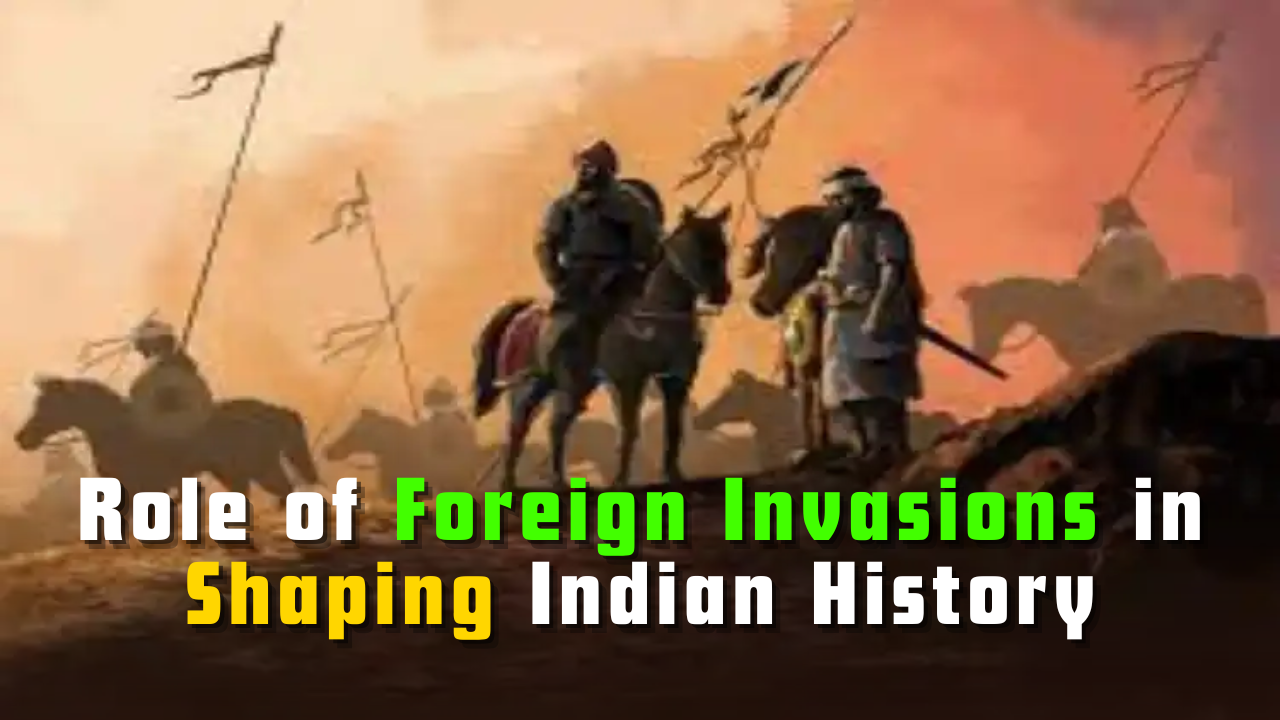Role of Foreign Invasions in Shaping Indian History
Foreign Invasions shaped India’s history through political, cultural & economic changes. From Aryans to Mughals & British, a must-read for UPSC.

Introduction
India’s rich and complex history has been significantly shaped by waves of foreign invasions spanning thousands of years. From the Aryans and Persians to the Greeks, Huns, Arabs, Turks, and Mughals, these invasions brought with them diverse cultural, religious, political, and economic influences. They contributed not only to India’s political restructuring but also enriched its art, architecture, language, and trade. This blog offers a detailed chronological and thematic analysis of these invasions and their impact, especially in the context of UPSC preparation.
Successive invasions transformed India’s political, cultural, and economic landscape. Invaders like the Turks and Mughals introduced new administrative systems and warfare techniques, which led to the rise of empires such as the Delhi Sultanate and Mughal Empire. These invasions fostered cultural syncretism through Indo-Islamic art and architecture, while also triggering resistance from native powers like the Rajputs and Marathas. Studying this helps to understand India’s historical resilience and its diverse socio-political fabric. Therefore, this topic becomes important for UPSC.
Foreign invasions have been a recurrent and formidable force in the grand narrative of Indian history. Far from being mere episodes of conquest and plunder, these incursions have acted as powerful catalysts, profoundly shaping the political, social, economic, and cultural landscape of the subcontinent. From the ancient Persian and Greek intrusions to the transformative British colonial era, each wave of foreign power has left an indelible mark, contributing to the complex and multifaceted identity of modern India. The role of these invasions can be understood through the dual lens of destruction and creation, leading to a continuous process of adaptation, assimilation, and synthesis that has defined the very essence of Indian civilisation.
Chronological Overview of Major Foreign Invasions
1. Aryan Invasion/Migration (c. 1500 BCE)
- Although debated, the Aryan migration theory suggests Indo-European tribes migrated into the Indian subcontinent from Central Asia.
- Introduced Vedic culture, Sanskrit language, and early forms of Hinduism.
- Established varna (caste) system, Vedic rituals, and tribal monarchies.
- Transition from pastoralism to settled agriculture.
Impact:
- Formation of early social structures.
- Vedic texts became the foundation of later Indian philosophy.
2. Achaemenid Invasion (c. 6th century BCE)
- Persian ruler Darius I annexed the northwestern part of the Indian subcontinent, including Gandhara.
- Incorporated into the Achaemenid Empire as a satrapy (province).
Impact:
- Introduction of Persian administrative practices.
- Promotion of long-distance trade via the Royal Road.
- Influence on Mauryan administrative systems.
3. Invasion of Alexander the Great (327–325 BCE)
- Alexander crossed the Hindu Kush and defeated King Porus at the Battle of Hydaspes.
- His campaign ended at the Beas River as his troops mutinied.
Impact:
- Hellenistic influence on Indian art (Gandhara School), coinage, and sculpture.
- Established Greek settlements and cultural exchange.
- Created a political vacuum in the northwest, leading to the rise of the Mauryan Empire.
4. Indo-Greek Rule (c. 2nd century BCE – 1st century CE)
- After Alexander’s departure, his generals established Indo-Greek kingdoms in Bactria and northwestern India.
- Most famous ruler: Menander I (Milinda).
Impact:
- Spread of Hellenistic art and coinage.
- Greek influence on Indian astronomy and medicine.
- Milinda Panha reflects interaction between Hellenistic and Buddhist philosophies.
5. Shakas (Scythians) (c. 1st century BCE)
- Nomadic tribes from Central Asia who settled in western India.
- Established rule in Malwa, Gujarat, and parts of Punjab.
Impact:
- Introduced Saka era (78 CE).
- Patronage to Buddhism and urban development.
- Contributed to mixed Indo-Scythian art and culture.
6. Kushana Invasion (1st–3rd century CE)
- Central Asian nomadic tribe that ruled northern India and parts of Central Asia.
- Famous ruler: Kanishka.
Impact:
- Patronised Buddhism (especially Mahayana).
- Spread of Gandhara and Mathura schools of art.
- Facilitated Indo-Roman trade through the Silk Route.
7. Huna Invasion (5th–6th century CE)
- White Huns (Hephthalites) invaded India during the Gupta period.
- Temporarily disrupted Gupta administration.
Impact:
- Contributed to the decline of the Gupta Empire.
- Resulted in social instability and feudal fragmentation.
- Introduced new military strategies.
8. Arab Invasion (712 CE)
- Led by Muhammad bin Qasim, who conquered Sindh.
- Arabs remained confined to Sindh and Multan for centuries.
Impact:
- Initiated Indo-Arab trade and cultural interactions.
- Introduction of Islamic law and governance in Sindh.
- Limited religious and cultural integration.
9. Turkish Invasions (11th–12th centuries CE)
- Mahmud of Ghazni raided India 17 times, looting wealth from temples.
- Muhammad Ghori’s invasion led to the establishment of the Delhi Sultanate (1206 CE).
Impact:
- Political unification under the Delhi Sultanate.
- Introduction of Islamic architecture, administration, and cultural forms.
- Decline of regional kingdoms.
10. Mongol Threats (13th century CE)
- While Mongols did not establish permanent rule, they launched several invasions.
- Delhi Sultanate under Alauddin Khilji resisted Mongol threats effectively.
Impact:
- Strengthened military organisation and fortifications.
- Indirectly led to centralisation of power under the Khilji dynasty.
11. Timur’s Invasion (1398 CE)
- Timur (Tamerlane) invaded Delhi and caused large-scale destruction.
Impact:
- Weakened the Tughlaq dynasty.
- Contributed to the fragmentation of the Delhi Sultanate.
- Paved the way for later Mughal entry (Babur was Timur’s descendant).
12. Mughal Invasion and Empire (1526–1857 CE)
- Babur defeated Ibrahim Lodi at the First Battle of Panipat (1526).
- Established the Mughal Empire which lasted till the British annexation.
Impact:
- Political centralisation and administrative reforms.
- Persian art, architecture, language, and literature flourished.
- Composite culture (Ganga-Jamuni tehzeeb).
- Expansion of Indo-Persian culture and syncretism.
Major Foreign Invasions and Their Impact
| Invaders | Period | Region of Impact | Major Contributions |
| Aryans | c. 1500 BCE | North India | Sanskrit, Vedas, Varna system |
| Achaemenids | c. 6th century BCE | NW India (Gandhara) | Administrative models, Persian influence |
| Alexander | 327–325 BCE | Punjab and NW India | Hellenistic art, Greek settlements |
| Indo-Greeks | 2nd BCE–1st CE | NW India, Mathura | Gandhara art, Greek-Buddhist fusion |
| Shakas | 1st century BCE | Gujarat, Malwa | Urban growth, Saka era, coins |
| Kushanas | 1st–3rd century CE | North India, Central Asia | Gandhara art, Mahayana Buddhism |
| Huns | 5th–6th century CE | NW India | Feudalisation, decline of Guptas |
| Arabs | 712 CE | Sindh, Multan | Islamic law, Indo-Arab trade |
| Turks | 11th–12th century | North India | Delhi Sultanate, architecture, Persian influence |
| Timur | 1398 CE | Delhi | Destruction, decline of Sultanate |
| Mughals | 1526–1857 CE | Pan-India | Administration, art, Indo-Persian culture |
Thematic Impacts of Foreign Invasions
Ancient Encounters: Persians and Greeks (6th – 4th Century BCE)
Impact of Early Invasions on India
- The earliest significant invasions of India were by the Achaemenid Empire (Persia) in the 6th century BCE and the Greeks led by Alexander the Great in 326 BCE.
- These invasions were primarily concentrated on the northwestern frontiers of the subcontinent.
- While their direct political control was short-lived, their influence on India’s political landscape and culture was profound.
Political Impact
- The invasions exposed the vulnerabilities of the numerous small, fragmented kingdoms in India’s northwest.
- Alexander the Great’s withdrawal created a power vacuum that is believed to have paved the way for the rise of the Mauryan Empire.
- Chandragupta Maurya, guided by Chanakya, consolidated these territories to establish India’s first major pan-Indian empire, partly as a strategic response to foreign threats.
- Later Indian political systems were influenced by Persian administrative models, such as the use of satrapies (provinces) and the adoption of standardised coinage.
Cultural Exchange
- This era was marked by a dynamic exchange of ideas and cultural practices.
- The Kharosthi script, derived from the Aramaic script used in the Persian Empire, was introduced and became widely used in northwestern India.
- Hellenistic (Greek) influence led to the development of the Gandhara School of Art, which blended Greek and Roman artistic techniques with Indian Buddhist themes.
The Age of Turmoil: Huns, Turks, and the Delhi Sultanate (5th – 16th Century CE)
The Huna Invasions and the Decline of the Gupta Empire
- The invasions by the Huns during the 5th and 6th centuries CE severely damaged the Gupta Empire, often called the “Golden Age of India.”
- These incursions caused significant political fragmentation, the collapse of cities, and the disruption of trade routes.
- This instability allowed numerous regional powers to rise, marking a major political shift in northern India.
The Rise of the Delhi Sultanate
- Following the Huns, a series of invasions by Turkic peoples from the northwest took place.
- This culminated in the establishment of the Delhi Sultanate in 1206 CE, a turning point in Indian history.
Political Impact of the Delhi Sultanate
- The Sultanate introduced new systems of governance, such as the Iqta system, which involved assigning land revenue in place of a salary.
- Despite frequent internal conflicts and changes in dynasties, the Sultanate brought a degree of political unification to northern India after a long period of fragmentation.
Socio-Cultural Synthesis under the Sultanate
- The arrival of the Turks fostered a deep and lasting blend of Islamic and Indian traditions.
- Architecture: This is clearly seen in the development of Indo-Islamic architecture, a fusion of Persian, Turkic, and Indian styles. Key examples include the Qutub Minar and the Alai Darwaza.
- Religion and Philosophy: The era saw the flourishing of Sufism and the Bhakti movement, which promoted communal harmony and cultural mixing through their focus on love and devotion.
- Language: The Urdu language, a mix of Persian, Arabic, and local Indian dialects, also has its origins in this period.
The Mughal Apex (16th – 18th Century CE)
Arrival and Overview of the Mughal Empire
- The arrival of the Mughals under Babur in 1526 CE began another transformative phase in Indian history.
- At its peak, the Mughal Empire was one of the largest and most prosperous empires in the world.
Administration and Governance
- The Mughals created a highly centralised and efficient bureaucracy.
- The Mansabdari system was the core of their administration, integrating both military and civil services.
- This system helped create a loyal nobility and ensured a stable flow of revenue and troops.
- Their land revenue system, especially the reforms introduced by Todar Mal, heavily influenced later land administration on the subcontinent.
Cultural Achievements
- The Mughal era is celebrated for its remarkable achievements in art, architecture, and literature.
- Architecture: A unique style blending Indian and Persian aesthetics is showcased in magnificent monuments like the Taj Mahal, the Red Fort, and Fatehpur Sikri.
- Art: Mughal miniature painting reached its zenith during this period.
- Literature: Royal patronage led to a flourishing of literature in both Persian and various local languages.
The British Colonial Era (18th – 20th Century CE)
- The arrival of European powers, which led to the establishment of British colonial rule, was the most profound and disruptive foreign intervention in India’s history.
Economic Impact
- Pro-Britain Policies: British economic policies were designed to serve the interests of Britain’s industrial economy.
- Deindustrialisation: This resulted in the ruin of India’s traditional industries, such as textiles and handicrafts.
- Economic Transformation: India was converted into a supplier of raw materials for Britain and a captive market for British-manufactured goods.
- Drain of Wealth: The systematic transfer of wealth from India to Britain impoverished the nation and severely stunted its economic development.
- Land Revenue Systems: The introduction of new systems, like the Permanent Settlement, changed land ownership patterns and often led to the severe exploitation of the peasantry.
Political Impact
- Centralised State: The British established a highly centralised, bureaucratic government with a uniform legal and administrative system.
- Imposed Unity: While this created a form of political unity, it was imposed for administrative efficiency and imperial control, not organic growth.
- “Divide and Rule” Policy: The British deliberately intensified religious and social divisions to maintain their power, leaving a legacy of communal tensions that persists today.
Social and Cultural Impact
- Modern Education: Introduced to create a class of loyal Indian administrators, it also ironically exposed Indians to Western concepts of liberty, equality, and nationalism, which fuelled the independence movement.
- Social Reforms: The British enacted significant social reforms, including the abolition of Sati and the legalisation of widow remarriage.
- Negative Effects: The colonial experience led to an erosion of traditional institutions and fostered a sense of cultural inferiority among some sections of the Indian population.
Conclusion
Foreign invasions have been integral in shaping the Indian subcontinent’s political boundaries, religious trends, and cultural identities. They were not mere disruptions but facilitators of new syntheses that enriched India’s diversity. From the Aryans to the Mughals, each wave of invasion has left behind a legacy that continues to influence Indian civilisation.
Understanding these invasions provides valuable insights for UPSC aspirants in history, polity, culture, and international influence—helping them critically analyse India’s historical development from both indigenous and global lenses.
Subscribe to our Youtube Channel for more Valuable Content – TheStudyias
Download the App to Subscribe to our Courses – Thestudyias
The Source’s Authority and Ownership of the Article is Claimed By THE STUDY IAS BY MANIKANT SINGH





